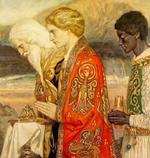Catholic Activity: St. Simon Stock, Traditional Feast May 16
Closely related to the feast of Our Lady of Mount Carmel is St. Simon Stock and the Brown Scapular.
DIRECTIONS
Close on the beginning of the thirteenth century there lived in deep solitude in Kent a young boy of about twelve years of age. He had chosen a hollow oak tree for his dwelling-place, from whence he derived his name of Stock. He was of good family, but had left all to live a life of prayer and meditation. Roots, herbs, and wild apples were his food; his drink, water from the running brook. Twenty years he lived this hermitical life. Then there came a rumor that a company of holy men had arrived from Palestine and were settling in England. Their home had been upon Mount Carmel, that beautiful hill that overlooks Galilee, Samaria, and the blue Mediterranean, where they had devoted themselves to contemplation. Their distinctive devotion was to our Blessed Lady, and theirs was the first church built to her honor. These holy men were the Carmelites or White Friars, who flourished so well in England. At the dissolution of the monasteries in the sixteenth century forty of their houses fell before the tyrant.
This was the order in its fresh, vigorous first fervor that Simon Stock joined, and in time became its sixth General. Then it was that he instituted the Confraternity of the Scapular. The members were to wear on shoulder and breast a piece of cloth, symbol of the Carmelite religious habit; they were to recite, if they could read--a necessary condition in those days--the Divine Office or the Office of our Blessed Lady, and abstain on Wednesdays, Fridays, and Saturdays from flesh meat.
Now, what was the motive that urged St. Simon Stock to found this Confraternity? Obviously a most generous, wide-hearted charity. As the first Christians divided all their temporal goods amongst their brethren, so this holy Carmelite invited all to share in the spiritual goods of his order. Many could not leave the world, could not lay aside the worldly dress and the customs of society. Let them, then, assume a symbolical dress, a badge of union which would remind them of a higher life and higher aims. They would put it on daily with their clothes; they would lie down with it at night, and by this one act of fidelity and reverence would participate in the spiritual good of thousands of holy souls, living and dead. No wonder such an invitation was readily accepted, and that crowned monarchs as Edward I. of England and St. Louis of France; that great saints as Charles Borromeo, Francis of Sales, and Alphonsus Liguori were enrolled in the Confraternity; that keen-sighted men as Father Aquaviva, the General of the Jesuits, recommended its use to his Society; that the old religious orders--Benedictines, Franciscans, and Dominicans--have defended and propagated the devotion. These are the children of light, and are keen-eyed where spiritual interests are at stake. One objection to the use of the scapular is sometimes raised: superstitious people use it as a charm; they wear it and live a life of liberty, trusting to its intrinsic merit to save them. This is folly, but such folly cannot affect the reverent use of the scapular. The good derived depends mainly on the dispositions of the wearer, not in the fact of wearing. These dispositions should be reverence for the symbol of a holy habit, desire to partake in the good works of the order, and devotion to the Immaculate Mother of God, whose champions the Carmelites have ever been.
But consolation comes from the very fact of wearing it too. It is a link with all that is good; it is an encouragement when downhearted, a test of fidelity, a badge of loyalty "to show which side I am on": it is a reminder of a holy past to those who go astray, and a pledge of our Lady's motherly protection. And what are the conditions of membership?
1. Enrolment by a duly authorized priest.
2. The use of the brown scapular night and day. 3. Special prayers only to gain special indulgences. Such conditions can deter nobody from enrolment.
Now, when business is to be transacted businessmen gather facts together, weigh the pros and cons, and regulate their actions according to right reason, at least from their point of view. We have the facts before us, we see the gain and the obligations. What are we going to do? Surely invest in a scapular if we have not got one, and if we have, renew our fervor in the wearing and refresh our memory as to the special indulgences and their conditions. Every good spiritual work is a link with God. We cannot have too many such links; for the way is long from here to Heaven; it is hard and wearisome, dangerous too. Let us wear our scapular, then, with reverence and humility and childlike confidence, looking to our Lady to know us for her own and provide for us now and at the hour of our death.
Activity Source: Feasts of Mother Church, The: With Hints and Helps for the Holier Keeping of Them by Mother Mary Salome, Benziger Brothers, 1904






